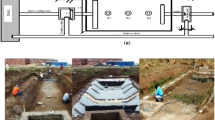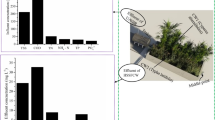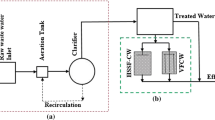Abstract
Sludge treatment beds (STBs) have been used widely in many countries due to low energy consumption, low operating and maintenance costs, and better environmental compatibility. Penetration, evaporation, and transpiration are the main processes for sludge dewatering in STBs. However, the leachate quality from STBs usually cannot meet discharge limits. Moreover, such leachate has very low COD/N ratio, which makes it difficult to treat. In the present study, two subsurface flow (SSF) constructed wetlands (CWs) were investigated for the treatment of leachate from STBs under three different hydraulic retention time (HRT) (3 days, 4 days, 6 days), aiming for evaluating the effects of plants and HRT on treatment performance, as well as the potential of SSF CWs to treat sludge leachate with low COD/N ration. The results showed that plants play an important role in leachate treatment. The best treatment performance was achieved with HRT of 4 days. In this condition, the mean removal efficiencies of COD (chemical oxygen demand), NH4+-N, TN (total nitrogen), and TP (total phosphorus) in the planted and the unplanted CWs were 61.6% (unplanted − 3.7%), 76.6% (unplanted 43.5%), 70% (unplanted 41%), and 65.6% (unplanted 6%), respectively. Heavy metal concentrations were below the Chinese integrated wastewater discharge standard during the experimental period in the planted CW, and the removal efficiencies in the planted CW system were higher than in the unplanted CW system. In all, planted SSF CWs can be an effective approach in removing leachate from sludge treatment beds. Furthermore, considering to temperature and seasonal variation, the leachate from STBs needs to be further studied in pilot- and full-scale condition.







Similar content being viewed by others
References
A D, Oka M, Fujii Y, Soda S, Ishigaki T, Machimura T, Ike M (2017) Removal of heavy metals from synthetic landfill leachate in lab-scale vertical flow constructed wetlands. Sci Total Environ 584-585:742–750
Bakhshoodeh R, Alavi N, Soltani Mohammadi A, Ghanavati H (2016) Removing heavy metals from Isfahan composting leachate by horizontal subsurface flow constructed wetland. Environ Sci Pollut Res 23(12):12384–12391
Březinová T, Vymazal J (2015a) Evaluation of heavy metals seasonal accumulation in Phalaris arundinacea in a constructed treatment wetland. Ecol Eng 79:94–99
Březinová T, Vymazal J (2015b) Seasonal growth pattern of Phalaris arundinacea in constructed wetlands with horizontal subsurface flow. Ecol Eng 80:62–68
Brix H (2017) Sludge dewatering and mineralization in sludge treatment reed beds. Water 9(3):160
Chen ZB, Hu SS, Hu CX, Huang LL, Liu HB, Vymazal J (2016) Preliminary investigation on the effect of earthworm and vegetation for sludge treatment in sludge treatment reed beds system. Environ Sci Pollut Res 23(12):11957–11963
Collison RS, Grismer ME (2013) Nitrogen and COD removal from domestic and synthetic wastewater in subsurface-flow constructed wetlands. Water Environ Res 85(9):855–862
Collison RS, Grismer ME (2015) Nitrogen and COD removal from septic tank wastewater in subsurface flow constructed wetlands: plants effects. Water Environ Res 87(11):1999–2007
Chinese EPA (2002) Discharge standard of pollutants for municipal wastewater treatment plant (GB 18918-2002), in Available at: http://www.kaola100.com/yijian/201611/21804045897.html. Accessed November 2018
Feng C, Huang L, Yu H, Yi X, Wei C (2015) Simultaneous phenol removal, nitrification and denitrification using microbial fuel cell technology. Water Res 76:160–170
Gajewska M, Obarska-Pempkowiak H (2013) Multistage treatment wetland for treatment of reject waters from digested sludge dewatering. Water Sci Technol 68(6):1223–1232
Gao J, Zhang J, Ma N, Wang W, Ma C, Zhang R (2015) Cadmium removal capability and growth characteristics of Iris sibirica in subsurface vertical flow constructed wetlands. Ecol Eng 84:443–450
García J, Rousseau DPL, MoratÓ J, Lesage ELS, Matamoros V, Bayona JM (2010) Contaminant removal processes in subsurface-flow constructed wetlands: a review. Crit Rev Environ Sci Technol 40(7):561–661
Ghosh D, Gopal B (2010) Effect of hydraulic retention time on the treatment of secondary effluent in a subsurface flow constructed wetland. Ecol Eng 36(8):1044–1051
Gill LW, Ring P, Higgins NMP, Johnston PM (2014) Accumulation of heavy metals in a constructed wetland treating road runoff. Ecol Eng 70:133–139
Grismer ME, Shepherd HL (2011) Plants in constructed wetlands help to treat agricultural processing wastewater. Calif Agric 65(2):73–79
Hafeznezami S, Kim J-L, Redman J (2012) Evaluating removal efficiency of heavy metals in constructed wetlands. J Environ Eng 138(4):475–482
Herrera-Cardenas J, Navarro AE, Torres E (2016) Effects of porous media, macrophyte type and hydraulic retention time on the removal of organic load and micropollutants in constructed wetlands. J Environ Sci Health A 51(5):380–388
Holcova V, Sima J, Edwards K, Semancikova E, Dusek J, Santruckova H (2009) The effect of macrophytes on retention times in a constructed wetland for wastewater treatment. Int J Sust Dev World 16(5):362–367
Hu SS, She XL, Wei XD, Hu B, Hu CX, Qian YQ, Fang YH, Zhang XR, Bashir S, Chen ZB (2017) Surplus sludge treatment in two sludge treatment beds under subtropical condition in China. Int Biodeterior Biodegrad 119:377–386
Jesus JM, Danko AS, Fiúza A, Borges M-T (2018) Effect of plants in constructed wetlands for organic carbon and nutrient removal: a review of experimental factors contributing to higher impact and suggestions for future guidelines. Environ Sci Pollut Res 25(5):4149–4164
Kengne ES, Kengne IM, Nzouebet WAL, Akoa A, Viet HN, Strande L (2014) Performance of vertical flow constructed wetlands for faecal sludge drying bed leachate: effect of hydraulic loading. Ecol Eng 71:384–393
Kengne IM, Kengne ES, Akoa A, Bemmo N, Dodane PH, Koné D (2011) Vertical-flow constructed wetlands as an emerging solution for faecal sludge dewatering in developing countries. J Water Sanit Hyg De 1(1):13–19
Kim B, Bel T, Bourdoncle P, Dimare J, Troesch S, Molle P (2018) Septage unit treatment by sludge treatment reed beds for easy management and reuse: performance and design considerations. Water Sci Technol 77(2):279–285
Kołecka K, Gajewska M, Obarska-Pempkowiak H, Rohde D (2017) Integrated dewatering and stabilization system as an environmentally friendly technology in sewage sludge management in Poland. Ecol Eng 98:346–353
Kołecka K, Gajewska M, Stepnowski P, Caban M (2019) Spatial distribution of pharmaceuticals in conventional wastewater treatment plant with sludge treatment reed beds technology. Sci Total Environ 647:149–157
Kołecka K, Obarska-Pempkowiak H, Gajewska M (2018) Polish experience in operation of sludge treatment reed beds. Ecol Eng 120:405–410
Kröpfelová L, Vymazal J, Švehla J, Štíchová J (2009) Removal of trace elements in three horizontal sub-surface flow constructed wetlands in the Czech Republic. Environ Pollut 157(4):1186–1194
Lu S, Zhang X, Wang J, Pei L (2016) Impacts of different media on constructed wetlands for rural household sewage treatment. J Clean Prod 127:325–330
Mayo AW, Hanai EE, Kibazohi O (2014) Nitrification–denitrification in a coupled high rate – water hyacinth ponds. Phys Chem Earth 72-75:88–95
Muñoz MA, Rosales RM, Gabarrón M, Faz A, Acosta JA (2016) Effects of the hydraulic retention time on pig slurry purification by constructed wetlands and stabilization ponds. Water Air Soil Pollut 227(9)
Pedescoll A, Sidrach-Cardona R, Sánchez JC, Bécares E (2013) Evapotranspiration affecting redox conditions in horizontal constructed wetlands under Mediterranean climate: influence of plant species. Ecol Eng 58:335–343
Petitjean A, Forquet N, Boutin C (2016) Oxygen profile and clogging in vertical flow sand filters for on-site wastewater treatment. J Environ Manag 170:15–20
Saeed T, Sun G (2012) A review on nitrogen and organics removal mechanisms in subsurface flow constructed wetlands: dependency on environmental parameters, operating conditions and supporting media. J Environ Manag 112:429–448
Sheoran AS, Sheoran V (2006) Heavy metal removal mechanism of acid mine drainage in wetlands: A critical review. Miner Eng 19(2):105–116
Sima J, Svoboda L, Pomijova Z (2016) Removal of selected metals from wastewater using a constructed wetland. Chem Biodivers 13(5):582–590
Stefanakis AI, Tsihrintzis VA (2012) Heavy metal fate in pilot-scale sludge drying reed beds under various design and operation conditions. J Hazard Mater 213-214:393–405
Sultana MY, Mourti C, Tatoulis T, Akratos CS, Tekerlekopoulou AG, Vayenas DV (2016) Effect of hydraulic retention time, temperature, and organic load on a horizontal subsurface flow constructed wetland treating cheese whey wastewater. J Chem Technol Biotechnol 91(3):726–732
Tao WD, Hall KJ, Duff SJB (2006) Performance evaluation and effects of hydraulic retention time and mass loading rate on treatment of woodwaste leachate in surface-flow constructed wetlands. Ecol Eng 26(3):252–265
Toet S, Van Logtestijn RSP, Kampf R, Schreijer M, Verhoeven JTA (2005) The effect of hydraulic retention time on the removal of pollutants from sewage treatment plant effluent in a surface-flow wetland system. Wetlands 25(2):375–391
Trang NTD, Konnerup D, Schierup H-H, Chiem NH, Tuan LA, Brix H (2010) Kinetics of pollutant removal from domestic wastewater in a tropical horizontal subsurface flow constructed wetland system: effects of hydraulic loading rate. Ecol Eng 36(4):527–535
Uggetti E, Ferrer I, Nielsen S, Arias C, Brix H, García J (2012) Characteristics of biosolids from sludge treatment wetlands for agricultural reuse. Ecol Eng 40(3):210–216
Uggetti E, Hughes-Riley T, Morris RH, Newton MI, Trabi CL, Hawes P, Puigagut J, Garcia J (2016) Intermittent aeration to improve wastewater treatment efficiency in pilot-scale constructed wetland. Sci Total Environ 559:212–217
Valipour A, Ahn YH (2016) Constructed wetlands as sustainable ecotechnologies in decentralization practices: a review. Environ Sci Pollut Res 23(1):180–197
Vera I, Verdejo N, Chavez W, Jorquera C, Olave J (2016) Influence of hydraulic retention time and plant species on performance of mesocosm subsurface constructed wetlands during municipal wastewater treatment in super-arid areas. J Environ Sci Heal A 51(2):105–113
Vymazal J (2005) Removal of heavy metals in a horizontal sub-surface flow constructed wetland. J Environ Sci Health 40(40):1369–1379
Vymazal J (2007) Removal of nutrients in various types of constructed wetlands. Sci Total Environ 380(1–3):48–65
Vymazal J (2011a) Constructed wetlands for wastewater treatment: five decades of experience. Environ Sci Technol 45(1):61–69
Vymazal J (2011b) Plants used in constructed wetlands with horizontal subsurface flow: a review. Hydrobiologia 674(1):133–156
Vymazal J (2016) Concentration is not enough to evaluate accumulation of heavy metals and nutrients in plants. Sci Total Environ 544:495–498
Vymazal J, Kröpfelová L (2015) Multistage hybrid constructed wetland for enhanced removal of nitrogen. Ecol Eng 84:202–208
Wang R, Korboulewsky N, Prudent P, Domeizel M, Rolando C, Bonin G (2010) Feasibility of using an organic substrate in a wetland system treating sewage sludge: impact of plant species. Bioresour Technol 101(1):51–57
Yadav AK, Kumar N, Sreekrishnan TR, Satya S, Bishnoi NR (2010) Removal of chromium and nickel from aqueous solution in constructed wetland: mass balance, adsorption–desorption and FTIR study. Chem Eng J 160(1):122–128
Zhang CB, Liu WL, Wang J, Ge Y, Gu BH, Chang J (2012) Effects of plant diversity and hydraulic retention time on pollutant removals in vertical flow constructed wetland mesocosms. Ecol Eng 49:244–248
Acknowledgements
The authors are grateful to Mark Francis Sixsmith for revising the English language.
Funding
Shanshan Hu received support from the China Scholarship Council for the PhD scholarship (CSC, No. 201706760061). This work was supported by the Natural Science Foundation of Hubei Province (Grant no. 2014CFB928).
Author information
Authors and Affiliations
Corresponding author
Additional information
Responsible editor: Philippe Garrigues
Publisher’s Note
Springer Nature remains neutral with regard to jurisdictional claims in published maps and institutional affiliations.
Rights and permissions
About this article
Cite this article
Hu, S., Chen, Z., Lv, Z. et al. Purification of leachate from sludge treatment beds by subsurface flow constructed wetlands: effects of plants and hydraulic retention time. Environ Sci Pollut Res 26, 5769–5781 (2019). https://doi.org/10.1007/s11356-018-4006-7
Received:
Accepted:
Published:
Issue Date:
DOI: https://doi.org/10.1007/s11356-018-4006-7




